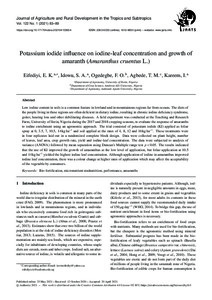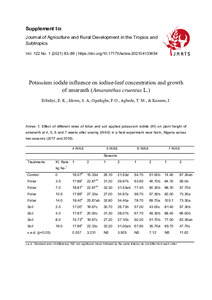| dc.date.accessioned | 2021-05-25T13:54:32Z | |
| dc.date.available | 2021-05-25T13:54:32Z | |
| dc.date.issued | 2021-05-25 | |
| dc.identifier | doi:10.17170/kobra-202104133654 | |
| dc.identifier.uri | http://hdl.handle.net/123456789/12849 | |
| dc.language.iso | eng | eng |
| dc.rights | Namensnennung 4.0 International | * |
| dc.rights.uri | http://creativecommons.org/licenses/by/4.0/ | * |
| dc.subject | bio-fortification | eng |
| dc.subject | micronutrient malnutrition | eng |
| dc.subject | performance | eng |
| dc.subject | amaranths | eng |
| dc.subject.ddc | 630 | |
| dc.title | Potassium iodide influence on iodine-leaf concentration and growth of amaranth (Amaranthus cruentus L.) | eng |
| dc.type | Aufsatz | |
| dcterms.abstract | Low iodine content in soils is a common feature in lowland and in mountainous regions far from oceans. The diets of the people living in these regions are often deficient in dietary iodine, resulting in chronic iodine deficiency syndrome, goiter, hearing loss and other debilitating diseases. A field experiment was conducted at the Teaching and Research Farm, University of Ilorin, Nigeria during the 2017 and 2018 cropping seasons, to evaluate the response of amaranths to iodine enrichment using an agronomic approach. The trial consisted of potassium iodide (KI) applied as foliar spray at 0, 3.5, 7, 10.5, 14 kg ha-1 and soil applied at the rates of 4, 8, 12 and 16 kg ha-1. These treatments were in four replicates laid out in a randomized complete block design. Data were collected on plant height, number of leaves, leaf area, crop growth rate, yield and iodine-leaf concentration. The data were subjected to analysis of variance (ANOVA) followed by mean separation using Duncan`s Multiple range test p < 0.05. The results indicated that the use of KI improved the growth of amaranthus at the low level of application, but foliar application at 10.5 and 14 kg ha-1 yielded the highest iodine leaf concentration. Although application of iodine in amaranthus improved iodine leaf concentration, there was a colour change at higher rates of application which may affect the acceptability of the vegetable by consumers. | eng |
| dcterms.accessRights | open access | |
| dcterms.creator | Eifediyi, Ehiokhilen Kevin | |
| dcterms.creator | Idowu, Samson Adeunie | |
| dcterms.creator | Ogedegbe, Felix Omonkeke | |
| dcterms.creator | Agbede, Taiwo Michael | |
| dcterms.creator | Kareem, Isiaka | |
| dc.subject.swd | Mikronährstoff | ger |
| dc.subject.swd | Mangelernährung | ger |
| dc.subject.swd | Amarant | ger |
| dc.subject.swd | Kaliumiodid | ger |
| dc.type.version | publishedVersion | |
| dcterms.source.identifier | eissn:2363-6033 | |
| dcterms.source.issue | No. 1 | |
| dcterms.source.journal | Journal of Agriculture and Rural Development in the Tropics and Subtropics (JARTS) | eng |
| dcterms.source.pageinfo | 83-89 | |
| dcterms.source.volume | Vol. 122 | |
| kup.iskup | false | |



